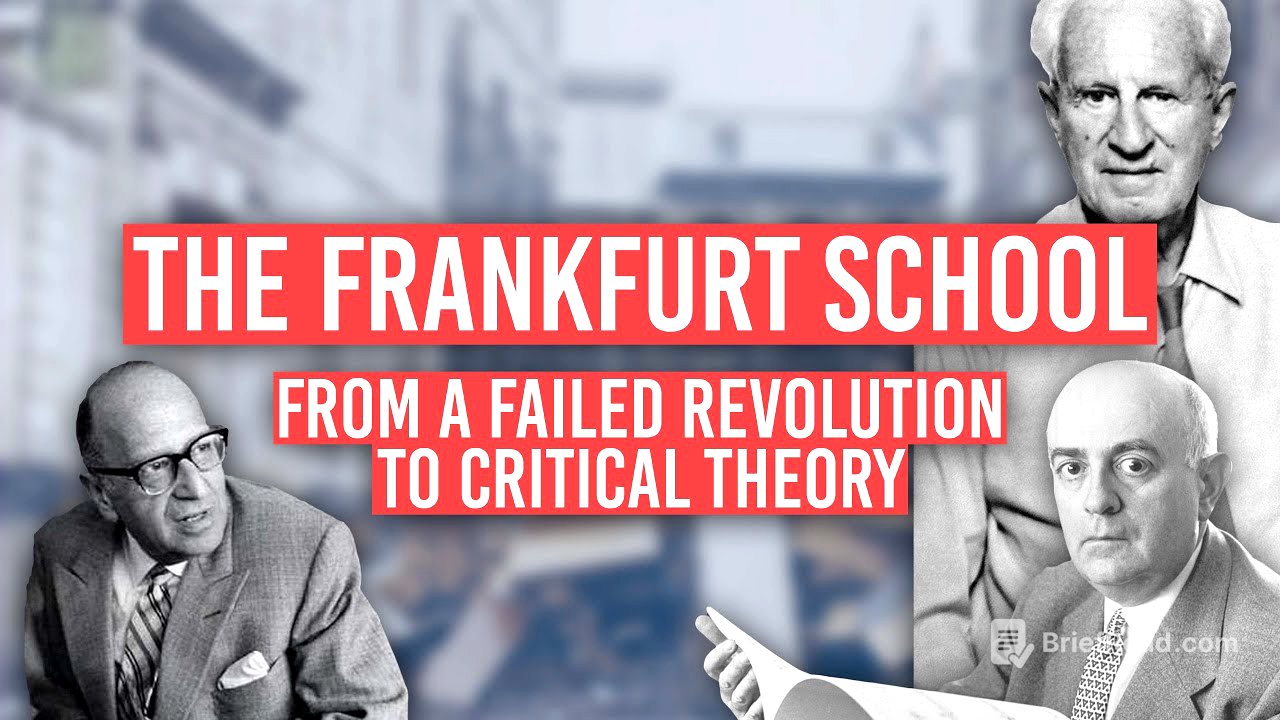TLDR;
This video provides an overview of the Frankfurt School, its historical context, key figures, and evolution of thought. It explores the school's origins in Marxist theory, its shift towards critical theory, its exile during the Nazi era, and its eventual return to Germany. The video also touches on the school's influence on various academic fields and its enduring relevance in contemporary society.
- The Frankfurt School emerged from a desire to understand the failure of socialist revolution in Germany.
- Key figures include Max Horkheimer, Theodor Adorno, Herbert Marcuse, and later, Jürgen Habermas.
- The school's work shifted from economic analysis to a broader critique of culture and society, focusing on the forces that discourage revolution and promote conformity.
- The Frankfurt School's time in exile during World War II led to significant works such as "Dialectic of Enlightenment," which critiqued the dark side of reason and the culture industry.
- Despite its radical origins, the school's revolutionary zeal faded over time, with its members often criticised for their pessimism.
Introduction [0:00]
The Frankfurt School, officially known as the Institute for Social Research, has significantly influenced the study of society and culture, securing its place on undergraduate reading lists. However, it has also faced criticism from political right figures who view it as undermining Western culture. This video aims to shed light on the Frankfurt School's history, work, and evolution, touching on its origins, global conflicts, collaboration with the CIA, and meetings with the Pope. The video will explore various aspects of the school's work and how their interests changed over time, serving as an introduction to more in-depth discussions on individual scholars and texts.
Historical Context and Origins [2:31]
In October 1918, Germany faced defeat in the First World War, leading to financial hardship and social tensions. Marxist intellectuals believed that the conditions were ripe for a communist revolution, similar to what had happened in Russia. However, the German revolution, led by Rosa Luxemburg and Karl Liebknecht, was outmanoeuvred by the Social Democratic Party, and Germany remained a capitalist nation. This failure prompted Felix Weil, the son of a wealthy grain merchant, to organise the first Marxist workweek in May 1923 to understand why Germany's revolution had not yielded economic reform. The participants felt that something more permanent was needed, leading to the establishment of the Institute for Social Research in Frankfurt in 1924, with Karl Grünberg as its first director.
The Institute Under Grünberg [6:03]
Karl Grünberg envisioned the Institute for Social Research as a centre for scientific socialism, focusing on economics, worldview, and research methods rather than party politics. The Institute aimed to engage in detached study informed by Marx's economic approach. Initially, the Institute's work focused on topics such as economy and society in China, the law of accumulation and collapse in the capitalist system, and experiments in economic planning in the Soviet Union. The stage theory of history remained intact, with the Institute concluding that the time for socialist revolution simply hadn't been right.
Horkheimer and the Shift to Critical Theory [7:49]
In 1930, Max Horkheimer, trained in psychology and philosophy, became the director of the Institute, leading to a shift away from economics and towards the social sciences. Horkheimer was sceptical of the inevitability of socialist revolution and saw empirical study as naive, assuming people would logically reject exploitation. He argued that capitalism had successfully integrated the working class, dividing those in long-term employment from the unemployed. Horkheimer's approach, along with scholars like Theodor Adorno, Erich Fromm, and Herbert Marcuse, encompassed social and cultural forces, seeking to understand why the working class was discouraged from overthrowing capitalism. In 1936, Horkheimer named this mode of societal analysis "critical theory," drawing on diverse fields to foreground how capitalism encourages conformity.
Exile and the Dialectic of Enlightenment [11:26]
In 1933, with the rise of Adolf Hitler, Horkheimer closed the Institute and led the Frankfurt School into exile, first to Geneva and then to Columbia University in New York. The rise of fascism and the USSR's slide into authoritarianism influenced the school's work, shifting the focus to why people embraced totalitarianism. This concern is central to "Dialectic of Enlightenment," a book by Horkheimer and Adorno, which locates the origin of totalitarianism in the Enlightenment. They argued that totalitarianism was not irrational but rather reason and rationality taken to the extreme, with the application of objectivism, uniformity, and standardisation reducing individuals to mere numbers. They also criticised the "culture industry" in capitalist nations, arguing that it creates sameness and robs people of their imagination.
The Authoritarian Personality and Return to Germany [15:47]
Adorno, along with other scholars at the University of California Berkeley, studied authoritarianism from a sociological and psychological standpoint, publishing "The Authoritarian Personality" in 1950. The book derived an F scale to identify an individual's likelihood of supporting a fascist political program. In 1949, with the defeat of Nazi Germany, Horkheimer moved the Frankfurt School back to its original home in West Germany. The Frankfurt School became a leading force in German sociological thinking, with critical theory influencing how scholars approached the study of human society, politics, and culture.
Later Works and the 1960s [18:35]
In 1951, Theodor Adorno published "Minima Moralia," arguing that human life was irrevocably damaged and that living a good, honest life was impossible. In 1964, Herbert Marcuse published "One-Dimensional Man," critiquing both capitalist society and the Soviet Union, arguing that critical thinking was becoming a dying art. Jürgen Habermas, who joined the school in 1956, increasingly disagreed with his mentors' defeatism. The divisions within the Frankfurt School came to a head in May 1968, when student protests broke out in France. While Horkheimer and Adorno remained sceptical, Marcuse was glad that his pessimistic pronouncements seemed to have been proven wrong.
Legacy and Conclusion [23:00]
Horkheimer and Adorno's refusal to find hope in the strikes and protests led to disruptions of Adorno's lectures. Horkheimer died in 1973, and Marcuse in 1978. In 1983, Jürgen Habermas became director of the Institute for Social Research. The Frankfurt School had an undeniable impact on how we critically analyse the world, discouraging a purely economic analysis of capitalism and promoting a more holistic study cognizant of social and cultural forces. Despite its radical origins, the school's revolutionary zeal faded over time, with its members often criticised for their pessimism. The Frankfurt School's diverse work has had a wide-ranging influence across fields, with a key theme being the potential for contemporary society to foster conformity and erode individuality.









